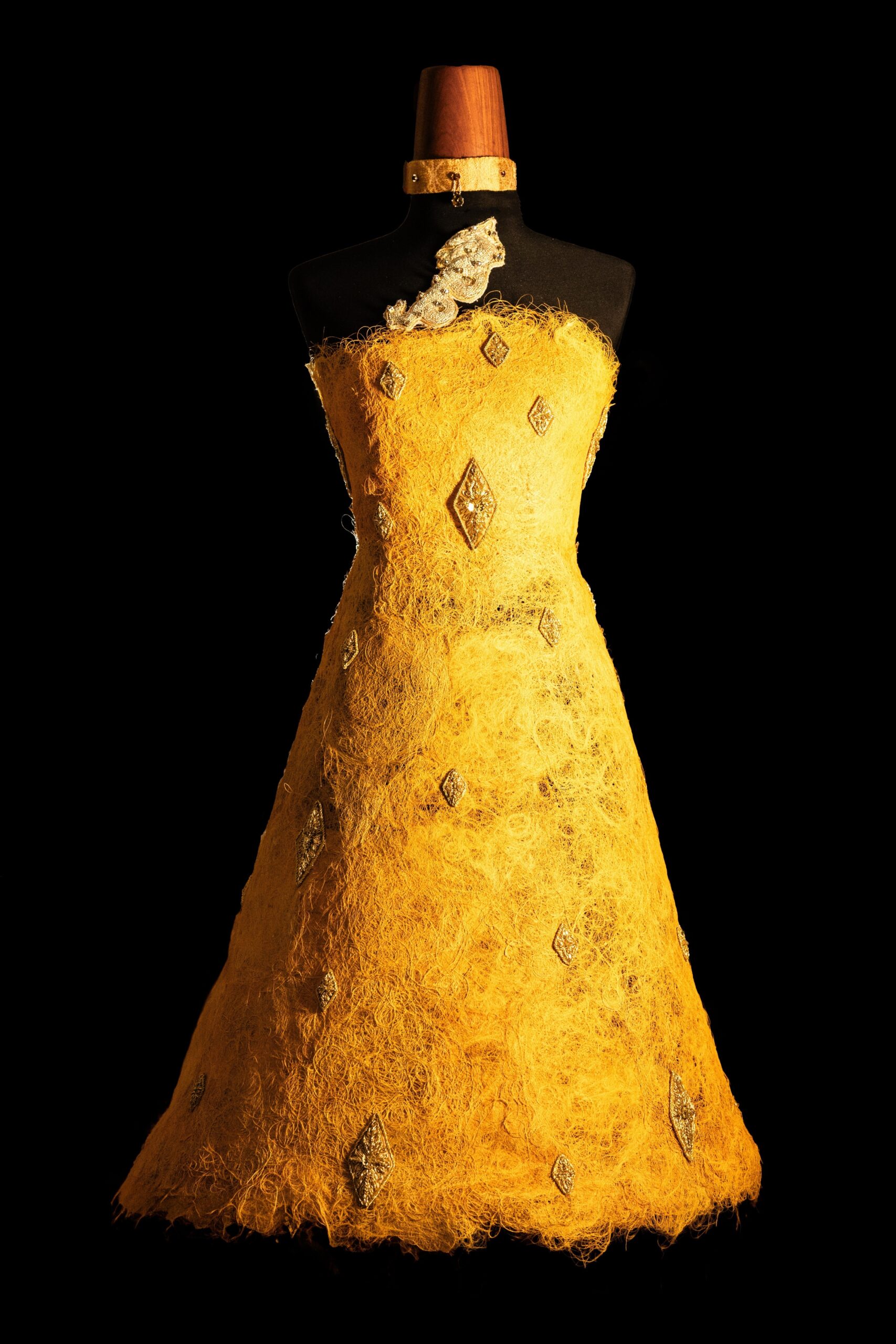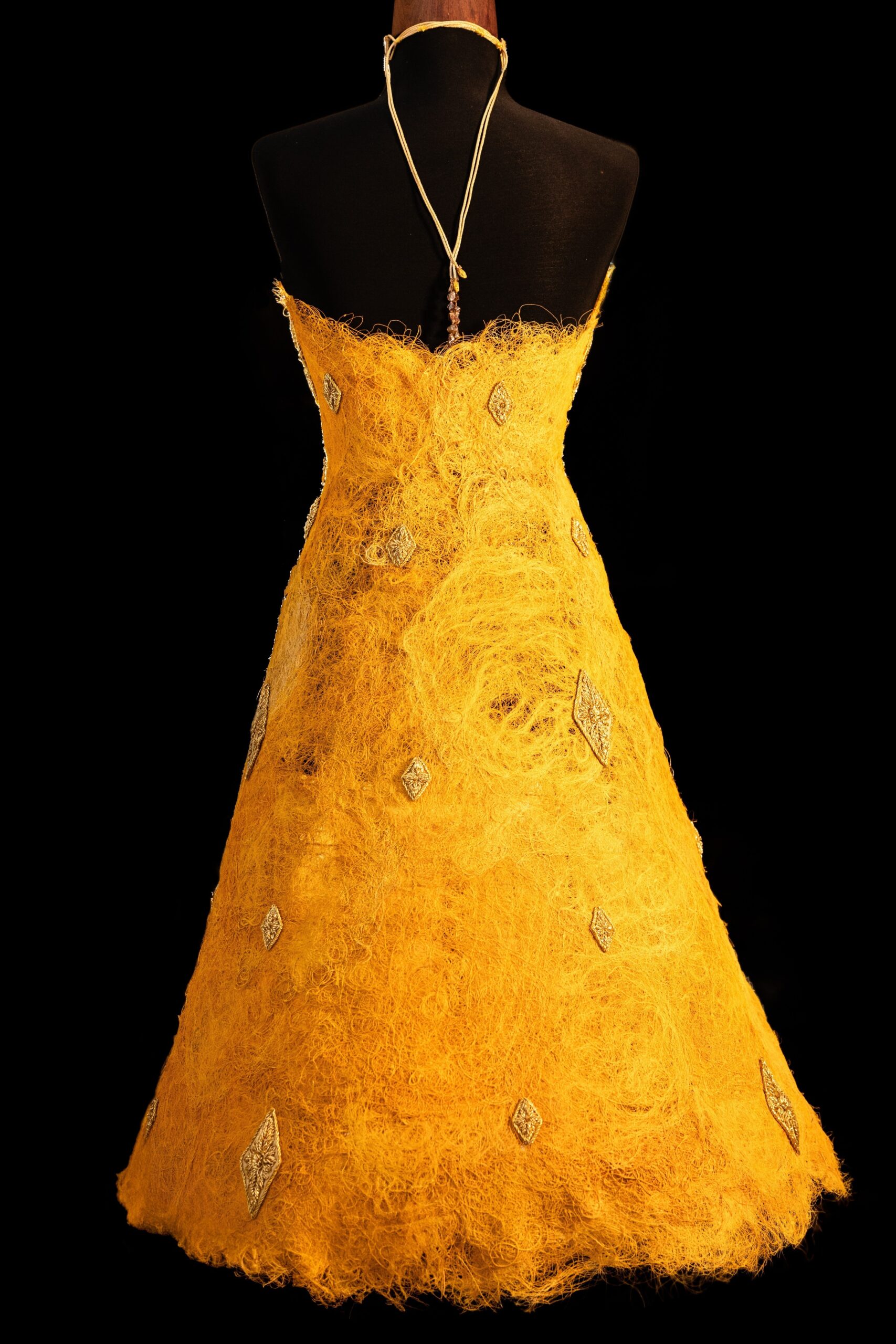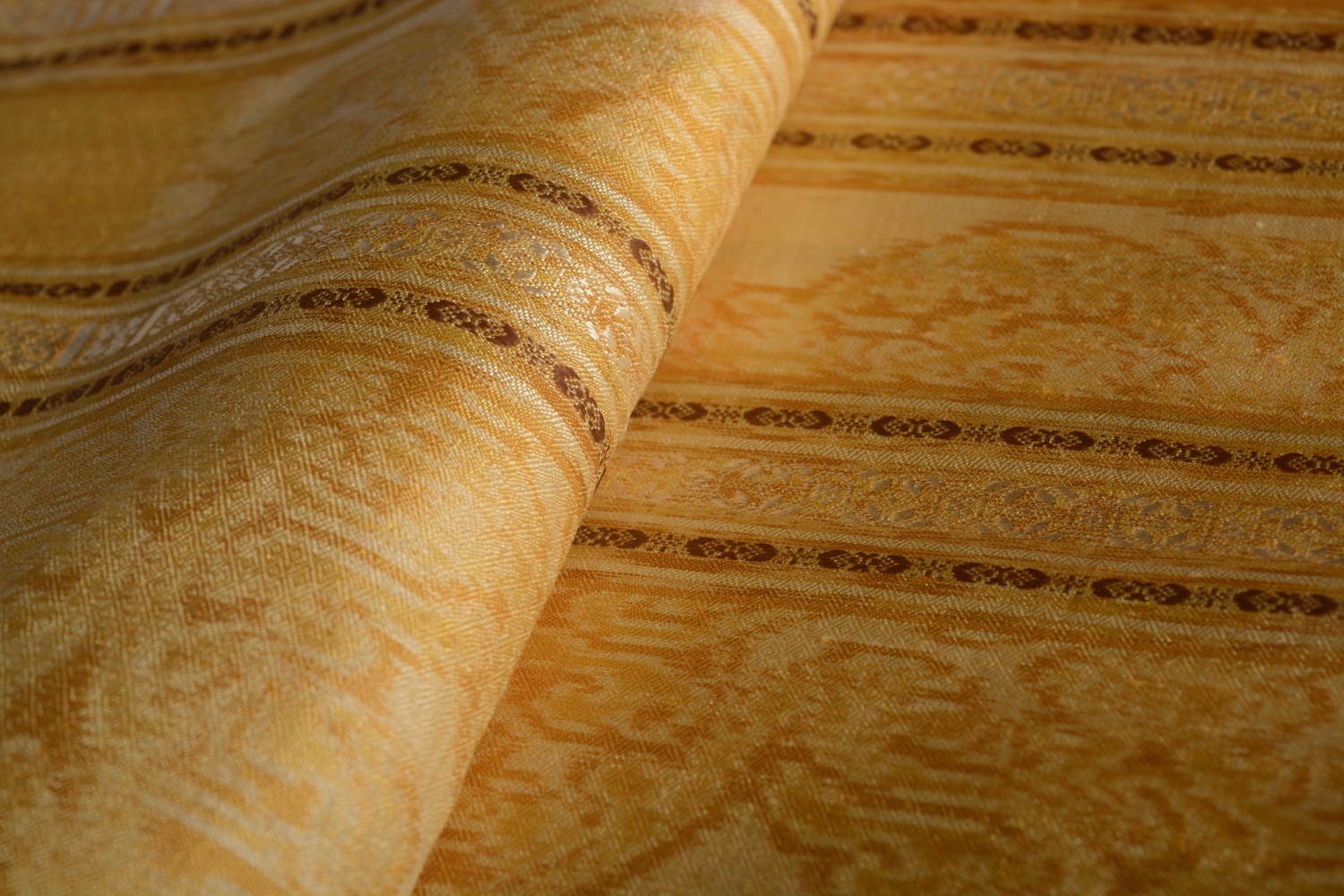The Zarmānī Dress
The Zarmānī Dress was created of undistorted natural golden silk threads by Golden Silk Pheach, designed by Sylvain and Keo Ly, costume designers for the Royal Khmer Ballet, the Draco constellation in copper, silver and gold zardosi embroidery with twenty encased natural precious Cambolite Zargun gemstones along with the Shanane Jay & Golden Silk Pheach Zarmānī jeweled choker accompanying the Zarmānī dress with natural Cambolite precious Zargun (Zircons), Golden Silk Pheach brocade, hand-forged silver palladium, and 21kt gold and silver zardosi were designed by Shanane Jay and created in collaboration with Golden Silk Pheach and Shanane Jay.
The Zarmānī dress is now on display in the Golden Thread, The art of dressing from North Africa to the Far East.
Musée du quai Branly-Jacques Chirac, Paris.


The etymology of the Zarmānī Dress
Zar is gold in Persian and Mānī a precious jewel in Sanskrit.
Ikat and Brocade Handloom Textiles
Ikat is created by binding individual threads, or bundles of threads, together with a tight wrapping following a pre-determined design pattern. The threads are then dyed with natural colour extracts. These bindings may then be altered and dyed again to create new patterns. This process can be done many times to produce elaborate, multicoloured patterns. In this process, the dye and resist are applied to the threads before weaving creating the design on the threads rather than on a finished piece of cloth. In brocade, the textile design is emphasised and wrought as additions to the main fabric being woven. Brocade creates on the textile face the effect of low and high relief. These additions present a distinctive appearance and rich three-dimensional patterns.
In both high-quality handmade ikat and brocade mediums textiles can take months to years to complete each piece.

Nazar
Nazar is deeply rooted in ancient cultures across the Middle East, South and Southeast Asia, and the Mediterranean. Nazar is a powerful belief in the use of natural black in objects to protect against the malevolent effects of the “evil eye”—a gaze thought to bring misfortune, illness, or bad luck. The concept of the evil eye dates back thousands of years, appearing in Hindu, Greek, Jewish, Norse and Islamic traditions, where it is often associated with envy and negative energy. Nazar can be an amulet, typically depicted as an eye, a object that has black or even a smudge of black makeup placed on a loved one. Black is worn or displayed to deflect harmful intentions and shield the wearer from unseen dangers. In traditional Hindu and Animist traditions, natural black gemstones and black threads are protective symbols found in sacred art, architecture, and even ritual markings. Spiritually, the Nazar is more than a mere charm; it serves as a reminder of the unseen forces at play in life, encouraging mindfulness, protection, and the cultivation of positive energy. Whether made of gemstones, metal, or glass, the Nazar carries the weight of cultural wisdom, bridging together the mystical with the material world.
Maya
The concept of Maya originates from ancient Hindu, Buddhist, and Animist traditions, representing the illusionary nature of the material world. In Sanskrit, Maya means “illusion” or “unreality,” referring to the veil that obscures true spiritual understanding. It is the belief that the physical world, with all its desires and attachments, is a fleeting illusion, while the ultimate truth lies beyond what can be seen or touched. In Hindu philosophy, Maya is closely linked to the divine play (Lila) of the universe, where reality is shaped by perception. Buddhist teachings also explore Maya as the deceptive nature of existence, emphasizing the path to enlightenment as a way to see beyond illusions and recognize the impermanence of all things. Spiritually, Maya serves as both a challenge and a guide—urging seekers to look deeper, question their perceptions, and move towards higher wisdom. As a symbol in art, jewellery, and sacred objects, Maya embodies the unseen forces that shape our journey, reminding us to seek clarity and truth beyond the material world.
Najananda
The concept of Najananda is a profound fusion of spiritual awakening and transcendent bliss. Rooted in ancient South Asian traditions, Najananda embodies the journey of moving beyond illusion (Maya) and fear (Nazar), stepping into a state of deep inner peace and enlightenment. The word itself can be understood as a combination of Naja, signifying protection or transcendence, and Ananda, the Sanskrit term for divine joy and boundless bliss. In Hindu and Buddhist philosophy, true Ananda is not found in material pursuits but in the realization of the self’s connection to the infinite. Najananda represents the triumph of wisdom over illusion, light over darkness, and spiritual freedom over worldly entanglements. It is a guiding force that encourages seekers to embrace both protection and liberation, finding harmony between the seen and the unseen. As a symbol, it inspires resilience, mindfulness, and the pursuit of a deeper, more enlightened existence.
Shivling
The Shivling is one of the most revered symbols in Hindu spirituality, representing the cosmic union of creation and destruction, masculine and feminine energies, and the infinite power of Mahadev Lord Shiva. Sacred stones, naturally formed and found in the Narmada River in India, are this representation, believed to carry intense spiritual vibrations that aid in transformation, healing, and enlightenment. The elongated, oval shape of the Lingham symbolizes the formless, eternal nature of Shiva—pure consciousness that transcends time and space—while the markings on the stone, often in shades of brown, red, and cream, represent the divine energy (Shakti) that brings balance to the universe. In temples and homes alike, the Shivling is worshipped as a powerful conduit for meditation, inner awakening, and the dissolution of ego. It serves as a reminder of the impermanence of life and the need to seek truth beyond material existence, aligning oneself with the eternal dance of the cosmos.
Panchratna: The Five Divine Gems and Their Astrological Significance
In Vedic astrology of Animist Hindu traditions, Panchratna refers to the five sacred gemstones believed to harness cosmic energies and influence the wearer’s destiny. Each gem is associated with celestial bodies and elements that govern different aspects of life, providing spiritual balance, healing, and protection. The five principal gemstones—Padmaraja (Padparadscha Sapphire), Mukta (Natural Pearl), Indra Nila (light Blue Sapphire), Vajra (white Diamond for men and coloured Diamond for women), and Marakatam (Emerald)—are chosen for their colour, purity, rarity, and alignment with spirituality, protection and planetary forces.
Worn as jewellery, Panchratna pieces are more than just adornments; they serve as powerful talismans that enhance well-being, success, and inner harmony. In traditional gem-setting practices, these stones are placed strategically to optimize their energetic influence, often incorporated into rings, pendants, bajuband (upper arm jewellery) or bracelets that maintain direct contact with the skin. Rooted in both astrological wisdom and the spiritual sciences of Ayurveda and Tantra, Panchratna jewellery connects the wearer to the cosmic order, aligning their aura with the divine rhythm of the universe.
Panchdhatu: The Sacred Alloy of Five Metals
Panchdhatu, meaning “five metals” in Sanskrit, is an ancient alloy deeply rooted in Vedic traditions, metallurgy, and spiritual practices. This sacred blend consists of gold, silver, copper, tin, and zinc. Each creation with Panchdhatu is believed to carry unique cosmic and astrological energies, working in harmony to balance the wearer’s body, mind, and spirit.
Referenced in ancient Sanskrit treaties and Hindu/Buddhist scriptures, Panchdhatu is revered for its beauty and mystical properties used in crafting sacred jewellery, and spiritual talismans. According to Shilpa Shastra, the ancient science of the rules of art, jewellery made from Panchdhatu is thought to channel positive vibrations, enhance well-being, and protect against negative influences. It is also associated with planetary alignment in Vedic astrology, aiding in the balance of celestial forces that govern human destiny.
Beyond its spiritual and astrological significance, Panchdhatu jewellery represents the interconnectedness of nature’s fundamental elements—earth, water, fire, air, and ether—making it a powerful symbol of wholeness, resilience, and divine energy.
Authentic panchdhatu using ancient formulas and processes all but disappeared by the early 19th century. What replaced it was often copper, iron and zinc and this has been sold as panchdhatu to an unknowingly consumer (iron is considered a unclean metal in Animist, Hindu and Buddhist spirituality and was never used historically).
At Royal Karkhana we were passionate about reviving this sacred metal in it’s truest form and to create exceptional pieces of jewellery using this historic precious metal alloy. For over a year Shanane Jay spent countless hours testing and creating pieces from ancient Indian metallurgy treaties until finally she succeeded in reviving historic panchdhatu. To separate Royal Karkhanas’ authentic panchdhatu from the illegitimate substitutes being sold on the market Royal Karkhana has named the panchdhatu we sell as Heritage Panchdhatu.

Golden Silk
With the benevolent protection of the murtis of the Angkor Temples, a priceless endemic species of silkworm has experienced a spectacular revival due to the patronage and dedication of Golden Silk Pheach in the Kingdom of Cambodia.
The Golden Silk Pheach revival initiative is located between the majestic 10th—to 13th-century Angkorian temples in Siem Riep Province, Kingdom of Cambodia. This rural area was the historic heartland of golden silk sericulture. The socially responsible and community-driven project has 50 individuals involved, from the growing of endemic mulberry trees to the sericulture, master dyeing, and artisan weavers.
This exceptionally rare golden silk was reserved historically only for members of the royal court. A sericulture infinitely finite, yielding less than 100 kilos per year, in all qualities, handwoven into masterpieces using millennium-old proprietary artisanal processes that cannot be mechanized, they exist only in the form of the hand made textile mediums of naturally coloured ikat and brocade by Golden Silk Pheach.

